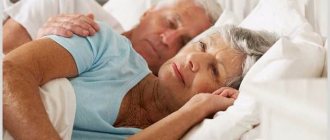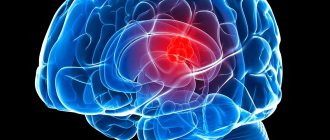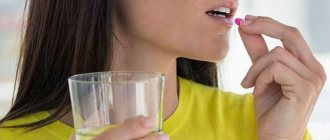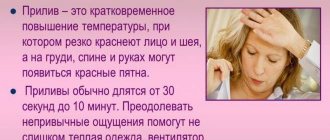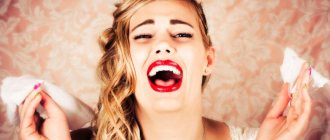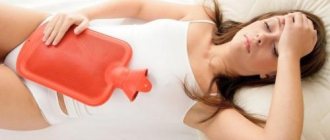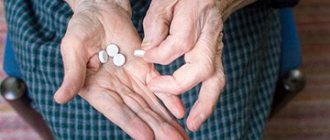Victoria Popova
Cardiologist
Higher education:
Cardiologist
Saratov State Medical University named after. IN AND. Razumovsky (SSMU, media) Level of education - Specialist 1990-1996
Additional education:
“Emergency Cardiology”
1990 - Ryazan Medical Institute named after Academician I.P. Pavlova
Contacts
More than 60% of women are susceptible to climacteric neurosis with vegetative-vascular disorders. More often, representatives of the fair sex encounter it when the time of menopause comes. The mood begins to change on its own, and asthenic syndrome occurs. Vascular dystonia often develops against the background of this disease. But you shouldn’t think that only women suffer from neuroses in combination with VSD. Increased stress at work can also cause seizures in men. Of course, the manifestations of diseases will differ. Next we will talk about methods of treating neuroses along with VSD.
Depression and VSD: is it normal?
With VSD, neuroses are very common. Almost all people suffering from vegetative-vascular disorders periodically fall into depression and despondency. In fact, absolutely all people are prone to this emotional state, and it is to some extent normal. This is how the human psyche reacts to nervous overstrain. Insomnia with VSD is one of the symptoms of depression. In women, the appearance of neurosis with vascular dystonia during menopause is associated with the following reasons:
- Poor nutrition. Sweating with VSD, increased heart rate and other manifestations of the disease may be the result of eating the wrong foods. In such situations, doctors advise limiting the amount of fat and sugar, because... It is these substances that load the blood vessels and heart.
- Smoking. Dry mouth with VSD develops in women due to frequent contact with tobacco smoke. In addition, nicotine has a very strong effect on the lungs and bronchi, so during menopause it is necessary to give up this habit.
- Stress. During menopause, many women become isolated in thoughts of getting old. This leads to the development of depression during VSD. During this difficult time, doctors advise choosing HRT and communicating more with loved ones. As for artificial hormones, they can be taken for the rest of your life without any negative health consequences.
- Lack of physical activity. The reluctance to subject the body to physical activity leads to the fact that all processes in the body begin to proceed more slowly. Stagnation of lymph occurs, hence the appearance of the figure deteriorates and brain function deteriorates.
Only the main factors leading to the development of VSD in menopausal neurosis are listed here. Genetic predisposition to such conditions also plays a role.
Treatment: main features
Treatment is not just about taking medications. Every woman with such a problem must follow the general recommendations of the doctor.
Features of the treatment of menopausal neurosis:
- Needs to be adjusted. Include vegetable, fermented milk and other various products containing calcium.
- Exclude from the diet: alcoholic and energy drinks, spices, strong tea or coffee. Please note that alcohol can cause hot flashes.
- Maintain a sleep and rest schedule. Patients with menopausal neurosis need to get a good night's sleep not only at the time of treatment, otherwise there will be no positive result.
- Walk more in the fresh air.
Psychotherapy
This condition should only be treated comprehensively. You should not expect improvement from taking medications alone.
After all, menopausal neurosis is a serious psychological problem, so it is necessary to strictly follow the recommendations described above and, if necessary, seek help from a psychologist.
Psychotherapy will help solve problems, thereby quickly stabilizing the woman’s general condition even without taking antipsychotics with a wide spectrum of action.
Drug treatment
Treatment tactics depend on the severity of clinical signs. In addition, before prescribing the drug, the doctor must take into account the patient’s age and medical history.
The age period is almost always accompanied by unpleasant symptoms. Therefore, in addition to the main treatment, it is necessary to additionally restore and maintain hormonal levels.
For, synthetic or homeopathic hormones are prescribed. As a rule, drugs are prescribed for this condition if a woman experiences panic attacks.
Low-dose drugs are used as treatment: estrogen, progesterone and androgen.
Dosage: hot temper during menopause, take 1 tablet per day. Klimonorm: a combined antimenopausal drug that contains gestagen and estrogen. The active components of the product help normalize the psychological and emotional state of a woman, thereby reducing the symptoms of neurosis. The drug has a wide list of contraindications, so it is dispensed from the pharmacy only with a prescription from a doctor.
If a woman exhibits pronounced signs, then Divigel is prescribed, which has a feminizing effect. The initial dosage is 1.0 g of gel, use once a day. If necessary, doctors prescribe the drug in cycles with a dosage of 1.5 g per day.
Often, with menopausal neurosis, a woman is prescribed the drug Melaxen, an adaptogenic agent (improves the functions of the hypothalamus and eliminates signs of neurosis). Dosage: take ½ tablet orally in the evening. It is best to take the medicine half an hour before bedtime.
Sedatives
During menopause, sedatives are also prescribed. The drug Grandaxin has proven itself well, the main component is tofisopam. It has a pronounced anxiolytic effect on the body. Prescribed in a dosage of 50-100 mg 2-3 times a day.
Ovestin is based on estriol (a natural analogue of the female hormone). The dosage is selected individually. Do not take the drug if: venous thrombosis, thrombophilia, severe diseases of the nervous system, as well as hypersensitivity to the additional composition of the drug.
Antidepressants
If panic attacks have a psychological basis, then in this case it is necessary to take antidepressants.
Natural antidepressants:
Valerian, Motherwort, Oregano.
Homeopathic antidepressants:
Inoclim, Remens.
Important! Do not take the listed drugs on your own; there is a wide list of contraindications, and there is also a risk of developing a severe adverse reaction.
Herbal treatment
Traditional methods of treatment can be used not only to normalize the menstrual cycle, but also to eliminate menopausal neurosis.
Recipe No. 1
Tincture based on prickly hawthorn. To prepare, you will need 1 tablespoon of chopped berries, pour 0.5 cups of alcohol. It is best to use 40%. Infuse for 14 days. Before use, strain, drink 20-30 drops 2-3 times a day.
Recipe No. 2
Tincture based on medicinal valerian. In a container, mix 1 tablespoon of dry ingredient and 250 ml of boiling water. Leave for 24 hours. Take 50-60 grams per day. The course of treatment lasts for a month.
Recipe No. 3
Collection based on medicinal herbs. You will need yarrow; to achieve a better result, add elderberry flowers and centaury grass. Take all the herbs in equal proportions, 10 grams each, pour boiling water (250 ml), leave for 30 minutes. Before use, strain through cheesecloth or a clean cloth. Take the finished product 30-40 ml 2 times a day.
Features of the manifestation of VSD in menopausal neurosis
During menopause, it is extremely problematic to diagnose VSD, because their symptoms are similar. Chills during VSD and menopausal neurosis occur with equal frequency. The difference between the two ailments is that one is influenced by the level of sex hormones, while the other occurs even in healthy people due to the peculiarities of the autonomic system. When both of these ailments are present, women experience the following symptoms:
- pressure surges;
- unpleasant taste in the mouth;
- constant desire to go to the toilet;
- severe headaches;
- a feeling of fear accompanied by panic or hysteria;
- pain in the heart area.
Coughing with VSD and menopausal neurosis indicates that a person does not receive enough oxygen. The mental state of the patients is most often to blame here. They set themselves up for negativity, so the heart works faster, the pressure changes abruptly and, in general, a general malaise occurs. Therefore, many doctors advise contacting doctors who specialize in psychotherapy for VSD.
Frequent ailments
People far from medicine may think that neurosis during menopause is the usual whims of middle-aged women. This opinion is wrong. Every second woman experiences the painful symptoms of menopausal neurosis to one degree or another.
A dangerous relationship arises between the instability of the lady’s emotional state and physical ailments. Deterioration in well-being causes a woman to become hot-tempered and tearful. Too violent emotional reactions become the culprits of tachycardia (rapid heartbeat), shortness of breath and insomnia.
Methods of psychotherapy used to eliminate VSD
Mental self-regulation has become widespread in vegetative-vascular dystonia. Thanks to her, many patients got rid of hyperhidrosis and other manifestations of this disease. Psychoneurological techniques are most effective when the patient is in a state of neurosis, asthenia or psychoasthenia. There are the following methods to combat attacks of VSD:
- Autotraining. Helps if the patient has cardiophobia.
- Personality psychoanalysis. It is used when a person demonstrates excessive anxiety about the results of his work.
- Art therapy, imagotherapy, personality correction. It is used when the patient demonstrates isolation and reluctance to talk to people, but from time to time they talk about their problems in order to evoke pity.
There are people who do not pay attention to the recommendations of specialists. They refuse to follow recommendations and try not to notice their own problem. In such situations, the doctor must try to reach the patient and his relatives, explain the essence of the disease and the fact that it needs to be treated.
Autotraining for VSD is considered the most effective method if a person has neurocirculatory disorders. Some patients are required to keep health diaries detailing their conditions. Observing work and rest schedules also helps a lot. Hypnotherapy is also used to treat neuroses and VSD, but the effectiveness of this technique has practically not been proven from a scientific point of view. Not all patients go into trance easily, and many simply make up memories.
Treatment of neuroses during menopause
Possible reasons.
The process takes into account the neglect of the condition. At an early stage, strong medications are not required. Experts recommend:
- Stick to the right diet. It is necessary to exclude alcoholic drinks, give up tea and coffee. Frequent use of spices and foods with high amounts of cholesterol is prohibited. The diet uses vegetables, dairy and plant products, and fruits.
- Get proper rest and sleep. Short breaks during the day are necessary.
- Go outside regularly to breathe fresh air. Spa treatment is useful.
- Do physical therapy and massage. This helps to maintain a good state of mind and maintain physical performance of the body.
Psychotherapy
Neurosis often develops against the background of psychological trauma and problems, so its treatment is impossible without the help of a psychologist. It is important to communicate regularly with a specialist and to be honest in conversations with him. There are often cases when stabilization of the condition occurs after psychotherapy sessions, without the use of sedatives or antipsychotics.
The selection of medications for menopause is carried out by a doctor individually. Preference is initially given to weakly acting antidepressants, drugs that are less harmful to the body. Among them are sedative sedatives, with the help of which:
- pulse stabilizes;
- blood pressure improves;
- sleep is normalized;
- the strength and frequency of hot flashes decreases.
To restore hormonal levels, hormone-based therapy is prescribed. The drugs used in this case are:
- synthetic;
- homeopathic.
Folk remedies for menopausal neurosis with VSD
Various depressions and mental disorders have been known since ancient times. At the same time, people with vascular dystonia began to appear. You should not think that all diseases are a product of civilization. Many diseases have existed for centuries. Traditional healers for VSD and neurosis recommend that patients visit the bathhouse more often, take baths with sea salt and try to be more active physically. Following these recommendations will help patients get rid of excess sweat.
For vascular dystonia and depression, teas with sage, mint, rose hips, and calendula help well. They help calm the nervous system. For a liter of liquid, just add a tablespoon of herb. Healing baths can be prepared with chamomile, pine or thyme. Do not throw plant leaves directly into an open container. You must first boil 300 grams of the product in boiling water, strain, and pour the mixture into the bath. The procedure should last no more than 30 minutes.

